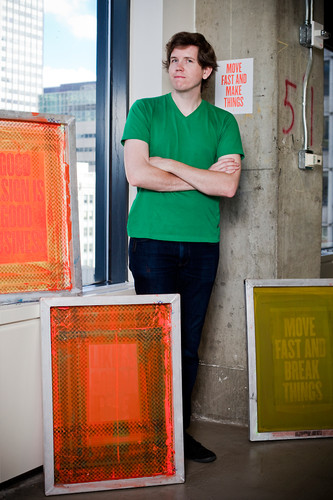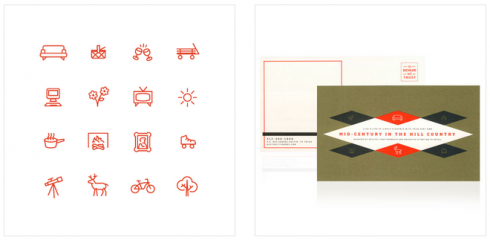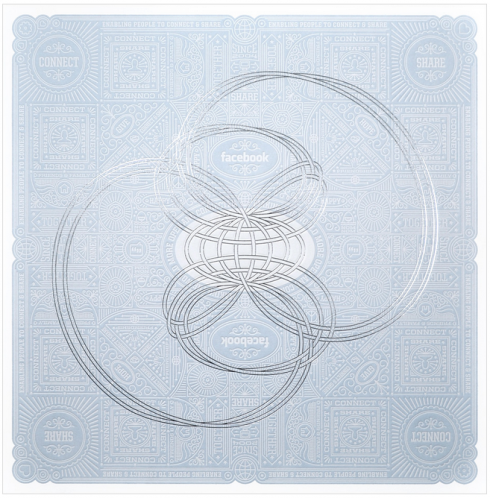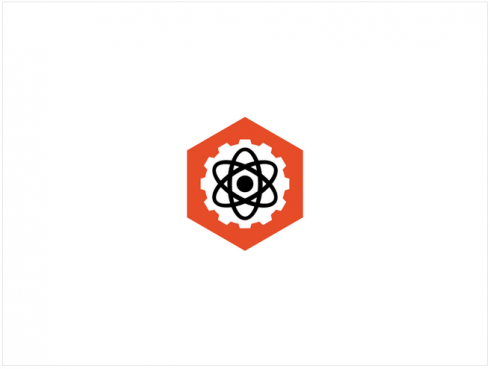In preparation for our event featuring Ben Barry next week at Sundance Cinemas, we sent a five questions to Mr. Barry to get a feel for his past and his future with Facebook and the Analog Research Laboratory.

Ben Barry and poster screens, image courtesy of fastcodesign.com
1. Tell us how you got started in design.
I was always interested in drawing and making things as a young kid. When I was about 9 or 10 I remember discovering Microsoft Paint while visiting my Dad’s office. From then on I was hooked. I got into computer aided drafting, architecture, and web design when I was in high school. When I entered college there was no web design major, so I landed in the Communication Design department in the art school. It was there that my eyes were fully opened to the world of graphic design.

Work done while at Decoder Ring, image courtesy of designforfun.com
2. What can you tell us about your experience working with Decoder Ring / Helms Workshop, and how it informed your design sensibility?
Aesthetically I was drawn to the work by Christian Helms when I was in college. It was smart, bold, simple, and beautiful. All things I still admire in design work today. More importantly though were the lessons I learned from Christian and Paul Fucik while I worked with them. Christian is an amazing story teller and communicator. I learned the importance of selling your ideas, and never accepting anything less than the best work. From Paul I learned to screen print, and enjoy life.

Facebook Holiday Gift, image courtesy of designforfun.com
3. How did you hook up with Facebook?
I’ve always been interested in technology for as long as I can remember, and particularly the internet. I signed up for Facebook when it launched at my university in November 2004. Despite my focus in school on more traditional design, I was an active participant in online culture. In 2008, while working for Decoder Ring, I logged into Facebook one night. Because I had in my profile that I was a designer I was shown a targeted advertisement saying that “Facebook is hiring designers.” Despite using Facebook for years at that point I didn’t know much about the company. I clicked the link and started reading. I applied that night, and several weeks later I was moving across the country. It was a difficult decision to leave Decoder Ring, and a lot of my friends and mentors thought I was crazy, but it’s been an amazing experience.

Analog Research Laboratory logo, image courtesy of designforfun.com
4. Few companies are as synonymous with our increasingly digital world as Facebook is. Yet ,the work you do for them is very much rooted in the analog world. Tell us about your Analog Research Lab and why it’s important.
I think it’s a mistake to see them as two separate worlds. Especially two that are at odds with one another. Both are about communicating information and connecting people to ideas and each other. These are basic human needs regardless of medium. To me both internet and print have a role to play in the future. It’s important to recognize when it’s appropriate to use which. The internet is obviously superior at information distribution, especially when it’s temporal in nature. Because it’s less efficient and more labor intensive printing should be though of less as a mechanism for information distribution, and more as a way to elevate certain ideas or content in their importance. I think people subconsciously sense the craftsmanship and quality in every object they encounter. Producing high quality printed material in a day and age when it isn’t the most efficient way to communicate is a signal of how much someone cares about an idea.

“The Facebook Wall” social experiment at the previous Facebook offices, image courtesy of designforfun.com
5. What would be your advice to creative teams that want to establish and define their internal culture? What would be their first steps?
Just start making stuff and putting it out there. Build and adapt from there. It’s really just that simple.

On Thursday, February 21, AIGA Houston is hosting a talk by Ben Barry at Sundance Cinema. Barry will be discussing his work at The Analog Research Laboratory, and how being organize and having the right tools can unveil routes to spontaneous creativity.
The event sold out over a week before the event date; however, AIGA Houston was able to secure a larger theater at Sundance, and advance ticketing has resumed. Tickets are $10 for members, or $15 for non-members. The event begins at 7pm, and attendees are encouraged to arrive early to mingle in the lobby’s bar and bistro. Parking is available in Theater District Parking Garage 7, or a short walk from Preston Station on the METRORail.
Interview conducted by Andy Rich, AIGA Houston President.